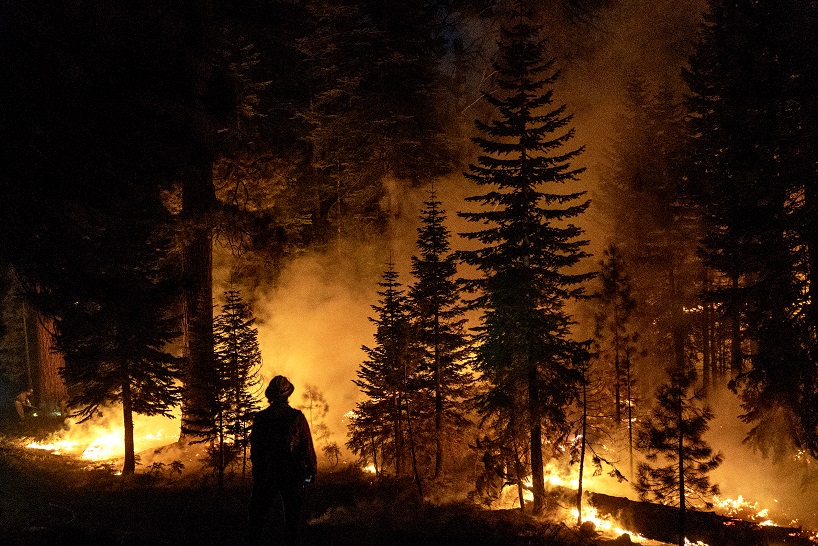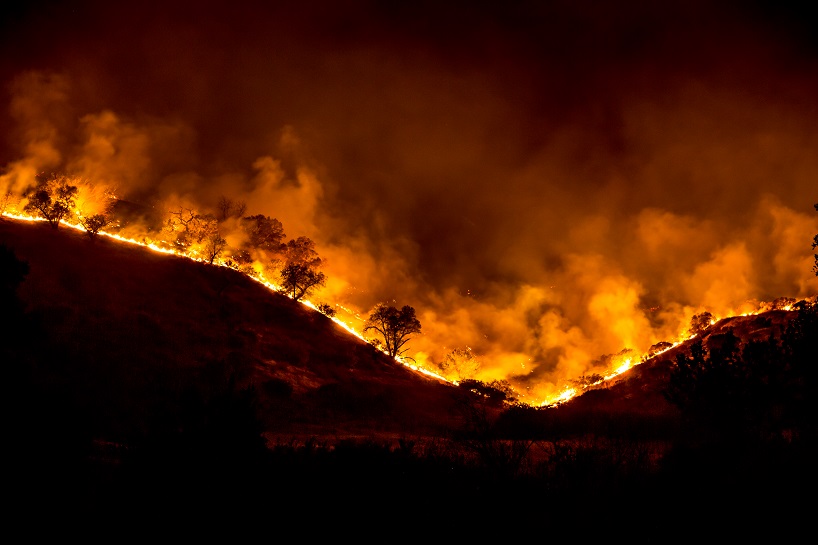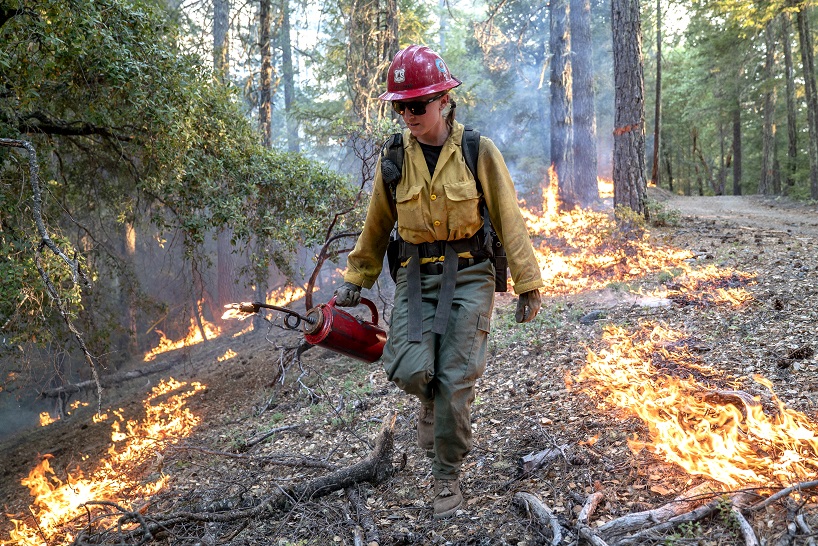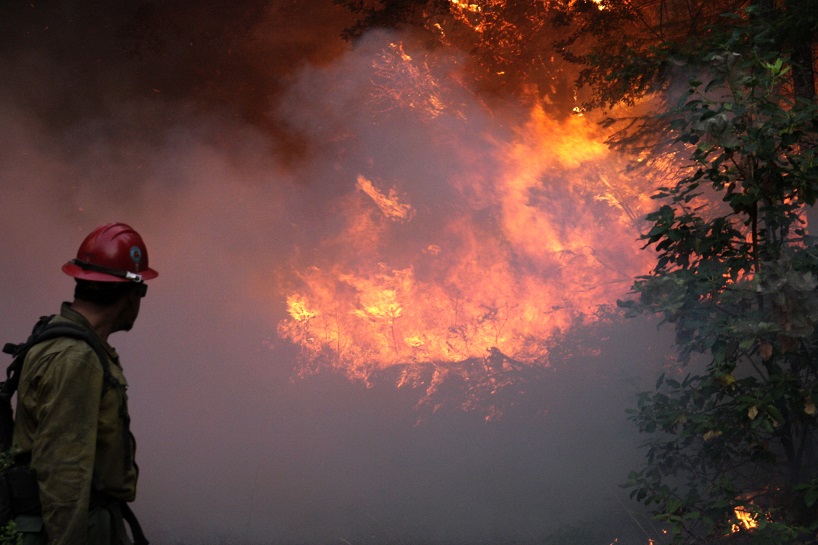Overview
 Donell Fire in Stanislaus National Forest in 2018. Photo courtesy of Cecilio Ricardo, USDA Forest Service.
Donell Fire in Stanislaus National Forest in 2018. Photo courtesy of Cecilio Ricardo, USDA Forest Service.
Since the 1980s, the size and intensity of wildfires in California have notably increased. Fifteen of the 20 largest wildfires in California history have occurred since 2000, and ten of the most costly and destructive fires to life and property in the state have occurred since 2015. Managing forests, woodlands, shrublands, and grasslands for broad ecological and societal benefits has become a challenging issue in California. Due to increasing fire size, frequency, and susceptibility to beetle outbreaks and drought driven mortality, forest biodiversity and composition is changing rapidly. Changes in vegetation structure alter important aspects of fire regimes (e.g., magnitude, frequency, seasonality), and these changes affect the management of biodiversity, groundwater management, forestry, recreation, as well as human safety. Atypically large patches of high-severity fire can hinder the ability of an ecosystem to recover, potentially undermining conservation of native biodiversity by long-term or permanent loss of native vegetation, expansion of non-native, invasive species, and long-term or permanent loss of essential habitat for native fauna. The devastating effects of recent wildfires have highlighted the need for California to reevaluate wildfire risk management and direct greater efforts toward wildfire resilience.
The California Department of Fish and Wildlife (CDFW) has many links to the topics of wildfire risk management and resilience. CDFW’s mission is to manage California’s diverse fish, wildlife, and plant resources, and the habitats upon which they depend, for their ecological values and for their use and enjoyment by the public. In accordance with this mission, CDFW balances the management of California’s natural resources with public health and safety. As a regulatory agency, CDFW is tasked with the management of a variety of native species, many of which rely on wildfire or habitat shaped by wildfire to thrive. CDFW is focused on working with partners to address new challenges from extreme wildfires and to create resilient landscapes that can allow for wildfire that promotes California ecosystems and biodiversity.
In the roles of a trustee agency and a responsible agency under the California Environmental Quality Act, CDFW reviews and comments on environmental documents for project activities that may impact fish and wildlife resources. Additionally, CDFW is the second largest state landholder in the state, with over 1,100,100 acres of fish and wildlife habitat. As a landholder, there is an obligation for CDFW to meet land management requirements by maintaining lands while meeting the associated mandates. Finally, CDFW is responsible for operating multiple grant programs and, through this role, provides funding to some projects that are directly linked to ecosystem (e.g., forests) and habitat health, which affects management of wildfires.
Managing wildfire resilience requires adoption of a landscape-scale perspective to take into consideration ecosystem and watershed health. An example of such a perspective is the Governor’s Forest Management Task Force (Task Force)(opens in new tab), established in 2018 and comprised of members from state, local, tribal, and federal agencies. The Task Force works at a landscape level to expand and improve forest management to enhance forest health and resiliency. The Task Force’s activities are informed and supported by the best science, thanks to scientific analysis and advice from its Scientific Advisory Panel. Through involvement in the Task Force and its affiliated Regional Prioritization Groups, CDFW participates in discussions about fire risk management and forest resilience.
Fire Ecology
 Woolsey Fire in 2018. Photo courtesy of Peter Buschmann.
Woolsey Fire in 2018. Photo courtesy of Peter Buschmann.
Almost all of California’s diverse ecosystems are fire-dependent or fire-adapted. Fire-dependent ecosystems need wildfire to maintain appropriate function and health, while fire-adapted ecosystems have evolved to survive wildfire. Fire elicits a different response from the species and vegetation communities in each ecosystem, but oftentimes, ecosystem ecology and dynamics are greatly influenced by wildfire. Fire can act as a catalyst for promoting biological diversity and healthy ecosystems, reducing buildup of organic debris, releasing nutrients into the soil, and triggering changes in vegetation community composition. Fire severity refers to the ecosystem impacts of a fire, and an individual fire may have a range of fire severity. Both high and low-severity fire areas provide important benefits for different wildlife and plant species.
Historic wildfire regimes, the pattern, timing, duration, and intensity in which fires naturally have occurred on the different vegetation communities and physical landscape, vary widely throughout the state. Through decades of management actions, such as wildland fire suppression, human expansion in to wildlands, and climate change, these regimes have been altered, producing an imbalance between wildfire and ecosystem interactions. For example, in forest ecosystems, dense stand conditions, combined with the effects of more frequent drought and other climatic change, have led many areas to become more vulnerable to pests (e.g., bark beetles), disease, and fire. The removal of natural fire from an ecosystem can lead to excess fuel buildup and changes in vegetation composition, which can increase the risk of uncharacteristically large high-severity fires.
Increases in uncharacteristically large wildfires can exacerbate impacts on both ecosystems and human communities. Expanded areas of high-severity fire can impact tree regeneration, soil erosion, and water quality. Communities continue to be impacted directly, through destructive fires in the Wildland-Urban Interface (i.e., areas where homes are built near or among lands that are prone to wildland fire), and indirectly, through poor air quality over large areas of the state.
Related
Wildfires and Climate Change
Changes in fuels, climate, and ignition patterns affect wildfire behavior, and climate change is just one factor that can exacerbate those changes. In addition to increasing the length of the wildfire season, climate change is amplifying drought frequency and severity. Drought causes moisture stress in vegetation, which leads to higher susceptibility to wildfire. Although California has received abundant precipitation in recent years, this rainfall does not necessarily erase the effects that years of severe drought have had on vegetation. Since vegetation may still be recovering from moisture stress during drought conditions, the high susceptibility to wildfire still persists despite the greater amount of precipitation.
Related
Fire Risk Management
 Hot Shot firefighter Laura Spellman uses a drip torch to burn lower vegetation to contain the oncoming fire in Mendocino National Forest in 2018.Photo courtesy of Cecilio Ricardo, USDA Forest Service.
Hot Shot firefighter Laura Spellman uses a drip torch to burn lower vegetation to contain the oncoming fire in Mendocino National Forest in 2018.Photo courtesy of Cecilio Ricardo, USDA Forest Service.
As the population of California continues to grow, more residents are living in the Wildland-Urban Interface, and with climate change increasing the length of the fire season, we continue to see more frequent, larger, high-severity wildfires impacting communities throughout the state.
Land managers use multiple types of fuel treatments to modify wildfire behavior and effects, including prescribed burning, mechanical thinning, prescribed herbivory, and mastication. It is critical that ecological impacts of the fuel treatments are considered in this process in order to avoid unintended consequences on wildlife and ecosystem health. Specifically, considerations include existing fuel conditions, vegetation types, and efficacy of the treatments with respect to management objectives for the site. In many cases, multiple treatment types are combined to achieve the desired results, such as mechanical thinning followed by prescribed burning. Appropriate design of these treatments can minimize the amount of unintended impacts on various ecosystem components.
Safely reintroducing fire back onto the landscape is essential to creating heterogenous, diverse vegetation and healthy ecological processes (e.g., water storage, pest resistance), promoting ecosystem resilience and enhancing biodiversity. The Task Force was convened to protect the environmental quality, public health, and economic benefits that healthy ecosystems, especially forests, provide to California. The Task Force is working toward increasing the rate of forest treatments and expanding the state wood product markets, to restore forest health in California. By encouraging discussion and searching for solutions to complex forest management and economic issues, the Task Force is taking a wholistic approach to addressing forest health and fire prevention. As a trustee agency for biological resources, CDFW is participating in these conversations to work towards healthy, resilient forests.
Related
Regulatory Context
 Redding Hotshot crew member conducts firing operation in Mendocino National Forest in 2018. Photo courtesy of Colby Jackson, Bureau of Land Management.
Redding Hotshot crew member conducts firing operation in Mendocino National Forest in 2018. Photo courtesy of Colby Jackson, Bureau of Land Management.
In September 2018, Governor Brown signed Senate Bill 901(opens in new tab), which set aside $200 million from the Greenhouse Gas Reduction Fund for forest health and fire prevention projects in order to work towards the goals laid out in the California Forest Carbon Plan (PDF)(opens in new tab) and reduce the risk of high-severity wildfire. The California Forest Carbon Plan aims to significantly increase the pace and scale of forest and watershed improvements on non-federal lands to 500,000 acres annually.
At the beginning of 2019, Governor Newsom issued Executive Order N-05-19, directing the California Department of Forestry and Fire Protection (CAL FIRE)(opens in new tab) to recommend immediate, medium, and long-term actions to help prevent destructive wildfires. In March 2019, N-05-19 was followed by the Governor’s Proclamation of a State of Emergency (opens in new tab)throughout California before the impending wildfire season. The State of Emergency proclamation addresses community vulnerability and wildfire fuel buildup by expediting selected forest management projects and allows for waivers of administrative and regulatory requirements to enable action to be taken within the next 12 months.
In response to this Executive Order, CAL FIRE identified 35 priority fuel-reduction projects that can be implemented immediately to help reduce the public safety risk of wildfire. Selection of these projects included three main analyses: evaluation of socioeconomic characteristics of communities that indicate vulnerability to wildfire, identification of priority projects based on existing CAL FIRE Unit Plans (i.e., plans for how each CAL FIRE Operational Unit will achieve the goals and objectives of the 2018 Strategic Fire Plan), and evaluation of wildfire risk within the proposed project area. The California Board of Forestry and Fire Prevention(opens in new tab) has prepared a Programmatic Environmental Impact Report for the California Vegetation Treatment Program(opens in new tab), which will facilitate vegetation management projects throughout the state.
Related